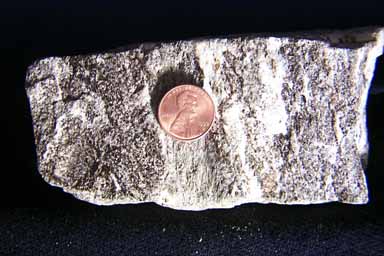|
GNEISS #4 (detail) Gneiss (bottom of rock) - Other specific examples: #1 | #2 | #3 | #4  Return to whole image
Return to whole imageReturn to detail >>> Return to previous >>> Return to first Return to: Alphabetical Listing Basic Key Advanced Key |
|||
Composition
|
Description
In this image we are looking at the bottom of the rock. Notice the light and dark colored bands. The light bands are quartz and feldspar, the dark bands are mostly biotite - that is the banding typical of a gneiss. What we are observing here is a cut (the bottom surface of the rock) slicing through the banding seen in the side of the rock. Look at the side view (clicking on the images will toggle you back and forth) and note how the dark and light colored layers intersect the bottom of the rock. That is what we are seeing in this view. The layering on the bottom is not sharp and distinct because of two reasons. One, the broken bottom surface is irregular and so cuts irregularly through the banding, and, two, some of the tight folds are truncated along the bottom of the rock meaning a band sometimes is exposed only a very little before ascending back up into the rock. |
||